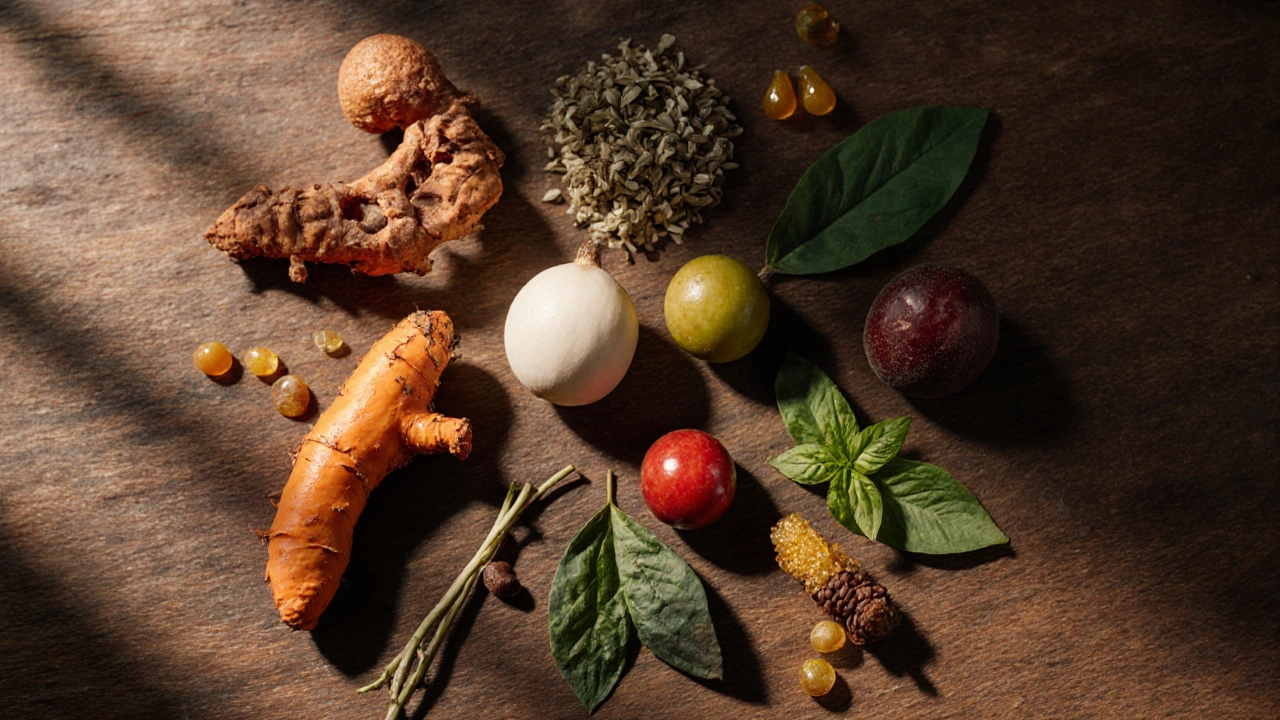Ayurvedic Medicine Dosage Calculator
Recommended Dosage
When people search for natural ways to support immunity, digestion, or stress relief, they often land on Ayurvedic medicines. Ayurveda, the ancient Indian system of health, relies on plant‑based formulations that have been refined over millennia. Below you’ll find a concise rundown of the ten most widely used Ayurvedic medicines, why they matter, how they’re typically taken, and what to watch out for.
Key Takeaways
- Turmeric, Ashwagandha, Triphala, Brahmi, Neem, Tulsi, Shankhapushpi, Amla, Guggul, and Guduchi form the core of modern Ayurvedic practice.
- Each herb offers a distinct set of benefits, from anti‑inflammatory action to cognitive support.
- Standardized extracts and reputable sources are vital for safety and efficacy.
- Most herbs are safe for healthy adults, but dosage, pregnancy, and drug interactions require caution.
- Buying from certified suppliers and checking for third‑party testing helps avoid adulterated products.
How Ayurveda Picks Its Medicines
Ayurvedic practitioners evaluate a herb on three main axes: rasā (taste), guṇa (quality), and vīrya (potency). Taste influences how the herb balances the three doshas-Vāta, Pitta, and Kapha. Quality describes its effect on the body’s tissues, while potency reflects the strength of the active compounds. Modern research often maps these traditional attributes to measurable actions such as antioxidant capacity, anti‑inflammatory effect, or neuroprotective activity.

The Top 10 Ayurvedic Medicines
1. Turmeric (Curcuma longa)
Turmeric is a rhizome that contains the active compound curcumin, known for its powerful anti‑inflammatory and antioxidant properties. Traditional uses include joint health, skin disorders, and digestive support. Standardized extracts (95% curcumin) are usually taken in 500‑mg capsules twice daily with black‑pepper oil to improve absorption.
2. Ashwagandha (Withania somnifera)
Ashwagandha is an adaptogenic herb that helps the body cope with stress and supports thyroid function. Clinical trials report reductions in cortisol by up to 30% after eight weeks of 300‑mg daily dosing of a root extract. It is popular for anxiety, sleep quality, and mild muscle strength gains.
3. Triphala
Triphala is a blend of three fruits-Amla, Haritaki, and Bibhitaki-used as a gentle digestive tonic and mild laxative. It supplies vitaminC, flavonoids, and tannins. Typical dosage is 1‑2g of powdered powder mixed with warm water before bedtime.
4. Brahmi (Bacopa monnieri)
Brahmi is a herb celebrated for its cognitive‑enhancing effects, especially memory retention and information processing speed. Standardized extracts (20% bacosides) are taken at 300mg twice daily, often linked to a 15‑20% improvement in recall tasks in healthy volunteers.
5. Neem (Azadirachta indica)
Neem possesses strong antimicrobial and anti‑parasitic properties, making it a go‑to for skin health and blood purification. Leaf extracts are commonly used in 250‑mg capsules once a day, while neem oil can be applied topically for acne or fungal infections.
6. Tulsi (Ocimum sanctum)
Tulsi-also called holy basil-acts as an adaptogen and respiratory aid, easing coughs and supporting the immune system. Fresh leaves are brewed as tea, or powdered leaf (300mg) is taken twice daily during cold seasons.
7. Shankhapushpi (Convolvulus prostratus)
Shankhapushpi is traditionally used for mental clarity, anxiety reduction, and insomnia. Clinical data suggest a modest rise in GABA activity. Standard dosage is 250mg of root extract, two times a day.
8. Amla (Phyllanthus emblica)
Amla is a vitamin‑C‑rich fruit that supports liver function, skin health, and antioxidant defenses. Powdered amla (1g) is mixed with honey or taken as a capsule (500mg) once daily.
9. Guggul (Commiphora wightii)
Guggul is a resin known for its lipid‑lowering and anti‑arthritic actions. Standardized extracts (2.5% guggulsterones) are dosed at 250mg twice daily, often combined with diet changes for cholesterol management.
10. Guduchi (Tinospora cordifolia)
Guduchi is praised for immune modulation and detoxification, especially during fever or post‑illness recovery. Tincture or powdered form (500mg) taken once a day aids in restoring vigor.
Quick Reference Table
| Herb | Primary Benefits | Common Form | Typical Adult Dose |
|---|---|---|---|
| Turmeric | Anti‑inflammatory, antioxidant | Standardized capsule | 500mg twice daily |
| Ashwagandha | Stress adaptogen, thyroid support | Root extract capsule | 300mg twice daily |
| Triphala | Digestive tonic, mild laxative | Powder or tablet | 1‑2g before sleep |
| Brahmi | Cognitive enhancer, memory | Leaf extract capsule | 300mg twice daily |
| Neem | Antimicrobial, skin health | Leaf extract capsule / oil | 250mg daily (capsule) |
| Tulsi | Respiratory aid, immune boost | Tea or powdered leaf | 300mg twice daily or 1‑2 tsp tea |
| Shankhapushpi | Anxiety relief, sleep support | Root extract capsule | 250mg twice daily |
| Amla | VitaminC source, liver support | Powder or capsule | 1g powder or 500mg capsule daily |
| Guggul | Cholesterol reduction, joint health | Resin extract capsule | 250mg twice daily |
| Guduchi | Immune modulation, detox | Tincture or powder | 500mg daily |

Safety, Interactions, and Contra‑indications
Most Ayurvedic medicines are well‑tolerated when sourced from reputable manufacturers, but several factors can affect safety:
- Pregnancy & breastfeeding: Turmeric in high doses, Guggul, and Ashwagandha are generally avoided during pregnancy.
- Blood‑thinning drugs: Neem, Turmeric, and Guggul may enhance anticoagulant effects, so talk to a clinician if you’re on warfarin or aspirin.
- Thyroid medication: Ashwagandha can raise T4 levels; monitor thyroid function tests if you’re on levothyroxine.
- Auto‑immune conditions: Immune‑stimulating herbs like Guduchi might exacerbate symptoms.
Start with half the recommended dose for the first week to gauge tolerance, then gradually increase. Always choose products that carry a third‑party testing seal (e.g., USP, NSF).
Where to Find Authentic Ayurvedic Products
Buying online can be convenient, but quality varies. Look for these hallmarks:
- Manufacturer based in India with GMP certification.
- Clear labeling of active ingredient concentration (e.g., “95% curcumin”).
- Batch‑specific testing results posted on the website.
- Return policy and customer support that can answer sourcing questions.
Specialty health stores in the UK-such as Holland & Barrett or independent Ayurvedic boutiques-often carry Ayurvedic brands that import directly from certified farms. For the most precise dosing, consider consulting a certified Ayurvedic practitioner.
Frequently Asked Questions
Can I mix multiple Ayurvedic herbs together?
Yes, many formulations deliberately combine herbs (e.g., Triphala). However, pairings should respect dosha balance and avoid overlapping side‑effects. If you’re unsure, start with a single herb and observe how your body reacts before adding another.
How long does it take to see results?
Herbs like Ashwagandha often show stress‑reduction benefits within two weeks, whereas cholesterol‑lowering effects of Guggul may need 8‑12 weeks of consistent use. Patience and regular dosing are key.
Are Ayurvedic medicines safe for children?
Some herbs, like Amla and Triphala, are commonly used in pediatric doses (often half the adult amount). Others, such as Ashwagandha and Guggul, are generally reserved for adults. Always consult a pediatrician or Ayurvedic specialist before giving herbs to kids.
Do these herbs interact with common prescription drugs?
Yes. Turmeric and Guggul can enhance blood‑thinner effects; Neem may affect diabetes medication; Ashwagandha can modify thyroid drug levels. Keep a list of all supplements and share it with your doctors.
What’s the best way to store powdered herbs?
Store in a cool, dry place away from direct sunlight. Airtight amber glass jars help preserve potency for up to two years.





